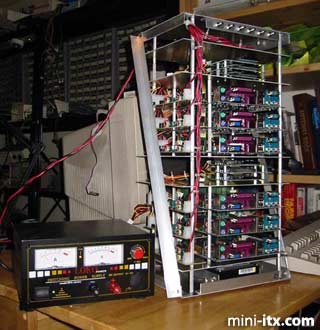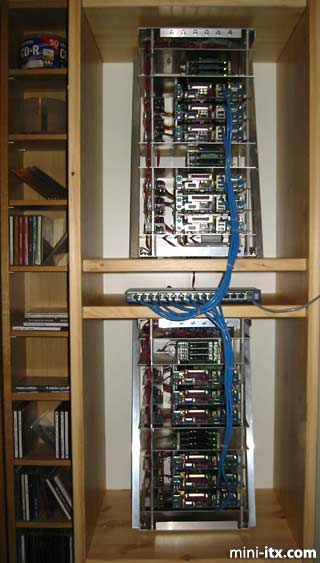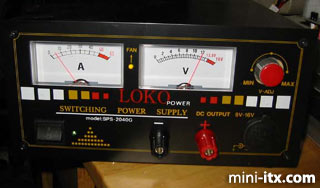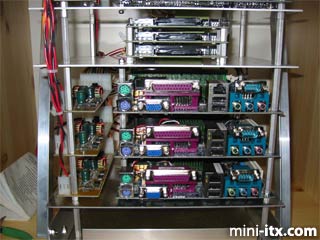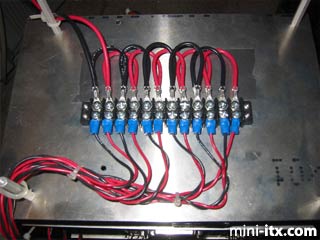Posted on February 25, 2004
Introduction
Early supercomputers used parallel processing and distributed computing and to link processors together in a single machine. Using freely available tools, it is possible to do the same today using inexpensive PCs - a cluster. Glen Gardner liked the idea, so he built himself a massively parallel Mini-ITX cluster using 12 x 800Mhz nodes.
The machine runs FreeBSD 4.8, and MPICH 1.2.5.2. After working with his machine and running some basic tests, Glen's cluster looks to be equivalent to at least 4 (maybe 6) 2.4Ghz Pentium IV boxes in parallel on a similar network - achieving a performance of around 3.6 GFLP. With the exception of the metalwork, power wiring, and power/reset switching, everything is off the shelf. Rather impressive we'd say - though he *is* root on a 1.1 TFLP 528 CPU monster, the 106th fastest computer in the world...
The "Mini-Cluster"
I built a Mini-ITX based massively parallel cluster named PROTEUS. I have 12 nodes using VIA EPIA V8000, 800 MHz motherboards. The little machine is running FreeBSD 4.8, and MPICH 1.2.5.2. Troubles installing and configuring Free BSD and MPICH were few. In fact, there were no major issues with either FreeBSD or MPICH.
The construction is simple and inexpensive. The motherboards were stacked using threaded aluminum standoffs and then mounted on aluminum plates. Two stacks of three motherboards were assembled into each rack. Diagonal stiffeners were fabricated from aluminum angle stock to reduce flexing of the rack assembly.
The controlling node has a 160 GB ATA-133 HDD, and the computational nodes use 340 MB IBM microdrives in compact flash to IDE adapters. For file I/O, the computational nodes mount a partition on the controlling node's hard drive by means of a network file system mount point.
Each motherboard is powered by a Morex DC-DC converter, and the entire cluster is powered by a rather large 12V DC switching power supply.
With the exception of the metalwork, power wiring, and power/reset switching, everything is off the shelf.
|
The original 6 node configuration.
|
The completed 12 node cluster.
|
This image shows the power use (60 watts) at idle for 6 nodes.
At present, the idle power consumption is about 140 Watts (for 12 nodes) with peaks estimated at around 200 Watts. The machine runs cool and quiet. The controlling node has 256 MB RAM , and an 160 GB ATA 133 IDE hard disk drive. The computational nodes have 256 MB RAM, each and boot from 340 MB IBM microdrives by means of compact flash to IDE adapters. The computational nodes mount /usr on the controlling node via NFS, for storage and to allow for a very simple configuration. No official benchmarks have been run, but for simple computational tasks the mini cluster appears to be faster than four 2.4 GHz pentium 4 mcahines used in parallel, at a fraction of the cost and power use.
Power and Cooling
Mini-ITX boards have very low power dissipation as compared to most motherboard/cpu combination in popular use today. This means that a Mini-ITX cluster with as many as 16 nodes won't need special air conditioning. Low power dissipation also means low power use, so you can use a single inexpensive UPS to provide clean AC power for the nodes.
In contrast, a 12-16 node cluster built with Intel or AMD processors will generate enough heat that you will likely need heavy duty air conditioning. Additionally, you will need adequate electrical power to deliver the 2-3 kilowatts peak load that your 12 node PC cluster will require. Plan on having higher than average utility bills if you use PC's...
Hardware Construction
The cluster is built in two nearly identical racks. Each rack has two stacks of three motherboards and dc-dc converters mounted on aluminum standoffs.
|
The compact flash adapters used to mount the microdrives are also in stacks of three. Each stack of boards is mounted on a 7 inch by 10 inch 0.0625 thick 6061-T6 aluminum plate as are the microdrive stacks. There are seven metal plates in all, in each rack.
|
The top cover plate has the mounting bracket for the 6 on/off/reset switches.
|
The plate below it is home to the power distribution terminal block. The power delivery cable for each rack is heavy duty 14 gauge stranded wire with pvc insulation. The power cabling from the terminal strip to each of the dc-dc converters is 18 gauge stranded pvc insulated hookup wire. The wiring for the power/reset switches is 24 gauge stranded, pvc insulated wire.
 |
 |
 |
Quick Links
Mailing Lists:
Mini-ITX Store
Projects:
Show Random
Accordion-ITX
Aircraft Carrier
Ambulator 1
AMD Case
Ammo Box
Ammo Tux
AmmoLAN
amPC
Animal SNES
Atari 800 ITX
Attache Server
Aunt Hagar's Mini-ITX
Bantam PC
BBC ITX B
Bender PC
Biscuit Tin PC
Blue Plate
BlueBox
BMW PC
Borg Appliance
Briefcase PC
Bubbacomp
C1541 Disk Drive
C64 @ 933MHz
CardboardCube
CAUV 2008
CBM ITX-64
Coelacanth-PC
Cool Cube
Deco Box
Devilcat
DOS Head Unit
Dreamcast PC
E.T.PC
Eden VAX
EdenStation IPX
Encyclomedia
Falcon-ITX
Florian
Frame
FS-RouterSwitch
G4 Cube PC
GasCan PC
Gingerbread
Gramaphone-ITX-HD
GTA-PC
Guitar PC
Guitar Workstation
Gumball PC
Hirschmann
HTPC
HTPC2
Humidor 64
Humidor CL
Humidor II
Humidor M
Humidor PC
Humidor V
I.C.E. Unit
i64XBOX
i-EPIA
iGrill
ITX Helmet
ITX TV
ITX-Laptop
Jeannie
Jukebox ITX
KiSA 444
K'nex ITX
Leela PC
Lego 0933 PC
Legobox
Log Cabin PC
Lunchbox PC
Mac-ITX
Manga Doll
Mantle Radio
Mediabox
Mega-ITX
Micro TV
Mini Falcon
Mini Mesh Box
Mini-Cluster
Mobile-BlackBox
Moo Cow Moo
Mr OMNI
NAS4Free
NESPC
OpenELEC
Osh Kosh
Pet ITX
Pictureframe PC
Playstation 2 PC
Playstation PC
Project NFF
PSU PC
Quiet Cubid
R2D2PC
Racing The Light
RadioSphere
Restomod TV
Robotica 2003
Rundfunker
SaturnPC
S-CUBE
SEGA-ITX
SpaceCase
SpacePanel
Spartan Bluebird
Spider Case
Supra-Server
Teddybear
Telefunken 2003
TERA-ITX
The Clock
ToAsTOr
Tortoise Beetle
Tux Server
Underwood No.5
Waffle Iron PC
Windows XP Box
Wraith SE/30
XBMC-ION

